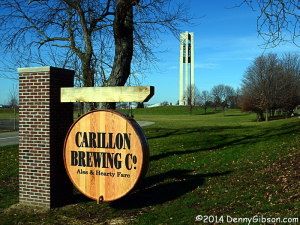 Ohio has a new brewery. It wasn’t desperately needed, I suppose, but this one is seriously different. There were already more than 100 breweries operating in Ohio and over 3000 in the country. A dozen other states also have more than 100 each. New mini, micro, and nano breweries are popping up everywhere everyday and, while I’m personally very happy to hear of each and every new launch, it’s a fact that the opening of a brewery is not as exciting and rare as it was just a few years ago. In an effort to distinguish themselves, some breweries are targeting the extremities of things that can be measured to claim titles like “the hoppiest” or “highest alcohol content”. How about “most labor intensive”?
Ohio has a new brewery. It wasn’t desperately needed, I suppose, but this one is seriously different. There were already more than 100 breweries operating in Ohio and over 3000 in the country. A dozen other states also have more than 100 each. New mini, micro, and nano breweries are popping up everywhere everyday and, while I’m personally very happy to hear of each and every new launch, it’s a fact that the opening of a brewery is not as exciting and rare as it was just a few years ago. In an effort to distinguish themselves, some breweries are targeting the extremities of things that can be measured to claim titles like “the hoppiest” or “highest alcohol content”. How about “most labor intensive”?
Carillon Brewing Company did not set out to be high on the labor used scale. It set out to be high on the historically accurate scale and provide a piece of living history befitting the 65 acre open air museum it is part of at Carillon Historical Park. It just turns out that, when you accurately recreate an 1850 brewery and use it to make beer the same way it was made more than a century and a half ago, things are going to be a bit more “hands on” than is normal today.
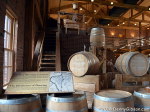
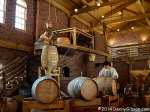
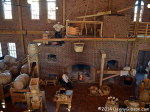 Though many are in really old buildings, the working bits of most breweries we see today look pretty modern. There are usually dials and gauges and maybe some electronics. One or more — sometimes many more — big — sometimes really big — stainless steel tanks are what actually identify a brewery to most of us. There are no steel tanks here and no fancy gauges. Definitely no electronically controlled automation.
Though many are in really old buildings, the working bits of most breweries we see today look pretty modern. There are usually dials and gauges and maybe some electronics. One or more — sometimes many more — big — sometimes really big — stainless steel tanks are what actually identify a brewery to most of us. There are no steel tanks here and no fancy gauges. Definitely no electronically controlled automation.

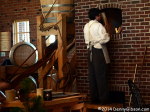
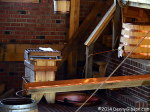 Here the beer is brewed in copper kettles and fermented in wooden barrels. Heat comes from wood fires and transferring the liquid between brewing steps is accomplished by hand dipping and gravity. One of the few concessions to modern times is the use of city water to save workers the chore of toting bucket after bucket from the nearby Great Miami River.
Here the beer is brewed in copper kettles and fermented in wooden barrels. Heat comes from wood fires and transferring the liquid between brewing steps is accomplished by hand dipping and gravity. One of the few concessions to modern times is the use of city water to save workers the chore of toting bucket after bucket from the nearby Great Miami River.
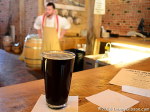
 The doors were opened in August with a full food menu and OPB (Other People’s Beer). In October, house brewed root beer and ginger ale were added. Last Thursday, December 11, two of Carillon Brewing’s own ales were introduced. The Porter (from an 1862 recipe) is pictured. I was served both it and the already downed Coriander Ale (1831 recipe) by Frank, the guy in the second picture. Note the period dress. Another modern concession is the use of refrigeration so that us twenty-first century wussies don’t have to drink warm beer. It is anticipated that some varieties will be served at room temperature to provide a true 1850 experience. Only ales will be brewed here. Even though lagering existed long before 1850, most breweries produced only ales until the mid 1860s
The doors were opened in August with a full food menu and OPB (Other People’s Beer). In October, house brewed root beer and ginger ale were added. Last Thursday, December 11, two of Carillon Brewing’s own ales were introduced. The Porter (from an 1862 recipe) is pictured. I was served both it and the already downed Coriander Ale (1831 recipe) by Frank, the guy in the second picture. Note the period dress. Another modern concession is the use of refrigeration so that us twenty-first century wussies don’t have to drink warm beer. It is anticipated that some varieties will be served at room temperature to provide a true 1850 experience. Only ales will be brewed here. Even though lagering existed long before 1850, most breweries produced only ales until the mid 1860s
 My new word of the day is “brewster”, a female brewer. Carillon Brewing’s Tanya Brock is that and more. Not only is she responsible for turning out something as tasty as those new stainless steel filled microbreweries, she must do it with historically accurate methods and recipes. Oh, and she has to research those methods and recipes, too. This is one unique operation. With justified pride, Brock says, “No one else in the United States is doing a fully-licensed production brewery in a historic museum.”
My new word of the day is “brewster”, a female brewer. Carillon Brewing’s Tanya Brock is that and more. Not only is she responsible for turning out something as tasty as those new stainless steel filled microbreweries, she must do it with historically accurate methods and recipes. Oh, and she has to research those methods and recipes, too. This is one unique operation. With justified pride, Brock says, “No one else in the United States is doing a fully-licensed production brewery in a historic museum.”

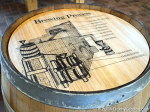
 The brewery is indeed part of a museum and vice versa. Signs, including several on barrel heads, explain brewing and its history in the area. One barrel head contains an annotated drawing of the brewing operation that stands behind it. Employees and volunteers are knowledgeable and happy to answer questions. Brewing currently takes place Wednesday through Saturday though watching it is sometimes akin to watching water come to a boil. Actually, between the flurries of activity moving the brew between steps, it is exactly like watching water come to an almost boil. Still, it’s mighty interesting. Nowhere else can you drink a beer truly made “the old fashioned way” while watching another batch being prepared for a future visit. You’ll leave not only refreshed and educated on nineteenth century brewing methods but, with just a little counting, knowing how may states were in the union in 1850.
The brewery is indeed part of a museum and vice versa. Signs, including several on barrel heads, explain brewing and its history in the area. One barrel head contains an annotated drawing of the brewing operation that stands behind it. Employees and volunteers are knowledgeable and happy to answer questions. Brewing currently takes place Wednesday through Saturday though watching it is sometimes akin to watching water come to a boil. Actually, between the flurries of activity moving the brew between steps, it is exactly like watching water come to an almost boil. Still, it’s mighty interesting. Nowhere else can you drink a beer truly made “the old fashioned way” while watching another batch being prepared for a future visit. You’ll leave not only refreshed and educated on nineteenth century brewing methods but, with just a little counting, knowing how may states were in the union in 1850.
EDITED 15-Dec-2014: Within a day of publishing this article, it struck me that the opening paragraph did not at all establish the right tone. In a move that I certainly won’t make a habit of, it has been rewritten. The original follows:
Ho hum. Ohio has another brewery. No, ho hum isn’t really what I want to say. I’m very happy to hear of each and every new launch but it’s a fact that the opening of a brewery is not as exciting and rare as it was just a few years ago. It’s not just Ohio, of course. There are now more than 3000 breweries in the country and new mini, micro, and nano breweries are popping up everywhere everyday. Ohio is just one of thirteen states with more than 100 breweries in operation. In an effort to distinguish themselves, some breweries are targeting the extremities of things that can be measured to claim titles like “the hoppiest” or “highest alcohol content”. How about “most labor intensive”?

Sometimes, visiting such places helps you in realizing that it takes a hell lot of effort to produce booze. And the bonus is, you can get a free beer as well.
Indeed it does. Aside from the samples typical of all bars serving craft brews, there’s no free beer here but I think that’s also typical of breweries other than the really big guys such as Yuengling. Another nearby place using historic methods to produce alcohol is Indian Creek Distillery which I visited in October.
Denny
Thank you so much for a wonderful article. You truly captured the spirit of what we are doing and why we are doing it. I am thrilled you enjoyed your visit and look forward to your next one.
Tanya Brock, Carillon Brewing Co Manager and Brewster
Big thanks for the compliments. This web thing is a hobby and my compensation comes purely from comments and other feedback. Yours felt just like a bonus and is much appreciated. I’ve been back just once since the tapping but I enjoyed it and will certainly return. It’s a fun place with good food and brew.